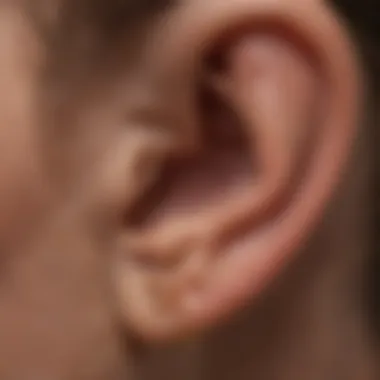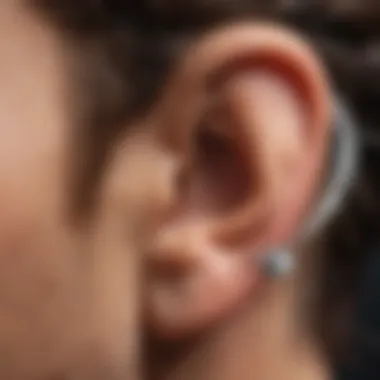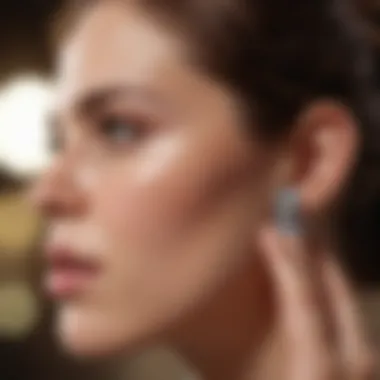Effective Techniques for Earwax Removal


Intro
Earwax, often considered an annoying inconvenience, is actually a crucial element of our ear health. Many people perceive it as a simple nuisance, but it plays a key role in protecting the ear canal from dust, debris, and pathogens. However, improper management of earwax can lead to blockages or painful infections. Therefore, understanding how to effectively dislodge earwax is essential.
This guide will delve into various methods, shedding light on safe practices, common misconceptions, as well as both home remedies and professional interventions. We'll also explore the anatomy of the ear to better appreciate how earwax works and the risks associated with excessive buildup. By the end of this article, readers will be equipped with valuable knowledge, enhancing their ability to maintain ear hygiene while making informed choices regarding ear care.
Let's dive in to discover effective methods for managing earwax, ensuring you can keep your ears healthy and functioning efficiently.
Understanding Earwax
Earwax, though often regarded as a nuisance, serves a critical function in ear health. This section lays the groundwork for understanding the importance and intricacies of earwax, a topic that warrants more attention than it commonly receives. Knowing what earwax is, its beneficial roles, and factors influencing its production helps demystify some misconceptions about it. This deeper insight can directly influence how individuals approach ear care and hygiene, making it crucial for our discussions throughout this guide.
What is Earwax?
Earwax, medically known as cerumen, is a naturally occurring substance produced in the ear canal. It's a mix of secretions from the sebaceous glands, sweat glands, and the shedding of skin cells. The color can vary from light yellow to dark brown, even sometimes appearing a little flaky or oily. This consistency changes because of several factors including diet, environment, and genetic background.
One might be surprised to learn that earwax undergoes a lifecycle. Initially, it's soft and moist, gradually becoming drier as it moves out of the ear canal. The ear has a remarkable self-cleaning mechanism; earwax naturally migrates to the outer ear, bringing with it dirt and particles.
The Role of Earwax in Ear Health
Here’s where the conversation becomes particularly interesting. Earwax is not just a nuisance; it plays several important roles in maintaining ear health. Primarily, it is a protective barrier against dust, bacteria, and foreign particles. By trapping these invaders, earwax helps prevent infections and supports the skin in the ear canal.
Additionally, earwax has antimicrobial properties, which means it can keep harmful microbes at bay. However, there’s more to it. It also assists in lubricating the ear canal, preventing the skin from drying out and cracking. This can be especially crucial in individuals prone to skin disorders.
"While often dismissed, earwax plays a vital role in safeguarding the inner workings of our ears."
Factors Influencing Earwax Production
Various influences can affect the amount and consistency of earwax someone produces. Genetics play a significant role; some individuals naturally generate more cerumen than others due to inherited characteristics. Environmental factors also have their say; living in more polluted areas can lead to increased earwax as the body tries to block out unwanted dirt and pollutants.
Other factors include:
- Age: Earwax tends to become drier and harder as one ages, which may affect its cleansing ability.
- Hygiene Practices: Frequent use of cotton swabs can lead to impacted wax, as they can push the wax deeper into the canal.
- Health Conditions: Certain ear conditions or syndromes can influence production, making it essential for anyone experiencing issues to consult with a healthcare provider.
Understanding earwax is not merely an academic pursuit. It influences how one approaches ave effective ear care practices, whether one is a health professional or someone simply looking for reliable information about maintaining ear hygiene. With this foundational knowledge, readers will be better equipped to make informed decisions about their ear health.
Signs of Excessive Earwax
Recognizing signs of excessive earwax is crucial for maintaining ear health. It's often easy to overlook minor discomforts, but being attentive to your body can prevent bigger issues down the road. Knowing the symptoms of earwax buildup enables timely intervention, potentially averting complications such as hearing loss or infections.
Common Symptoms of Earwax Buildup
When earwax begins to accumulate, it can produce a variety of symptoms that signal a problem. Some common indicators include:
- Hearing Impairment: A blocked ear can create a muffled sensation, reducing the clarity of sounds. If conversations seem quieter, that's a red flag.
- Tinnitus: A persistent ringing or buzzing in the ears can be a result of impacted earwax pressing against the eardrum.
- Ear Discomfort: You might feel a sense of fullness or pressure, akin to having a cotton ball stuck inside your ear.
- Itchiness or Irritation: Accumulated wax can lead to irritation in the ear canal, prompting frequent scratching.
- Odor: An unpleasant smell may emanate from the ear if excess wax traps bacteria.
These symptoms aren't just trivial nuisances; they indicate that the ear may not be functioning as it should. Addressing these symptoms early can save one from more complex treatment needs later.
When to Seek Medical Attention


If you’re experiencing any of the symptoms mentioned above, it may be time to consult a healthcare professional. In particular, you should seek medical attention if:
- Home remedies have not resolved the issue after a few days.
- You experience severe pain in the ear, which might indicate an infection.
- There is drainage of fluid that isn’t just wax. Fluid mixed with blood or pus could signal a more serious condition.
- You notice a sudden or significant change in hearing capacity.
Regular check-ups with an audiologist or an ENT specialist can help in catching earwax issues before they escalate.
Home Remedies for Earwax Removal
The use of home remedies for earwax removal is increasingly embraced by those looking for safe and effective solutions. It’s crucial to highlight that many people prefer these methods over more invasive procedures, owing to their accessibility and low cost. Moreover, they can be performed in the comfort of one's own home, which is a significant advantage. However, it is equally important to understand that while home remedies might be effective, they should be approached with caution to avoid potential risks like irritation or damage to the ear canal.
Using Oils for Softening Earwax
Olive Oil
Olive oil is widely recognized for its lubricating properties and is an excellent choice for softening earwax. This oil has a unique characteristic—its viscosity allows it to penetrate earwax effectively, making it easier to remove. People generally find olive oil beneficial because it is a natural product, reducing the risk of allergic reactions compared to synthetic alternatives. The main advantage lies in its ability to gently soften the wax, which can prevent excessive buildup. On the flip side, some individuals might encounter a mild irritation if they have sensitive skin, making it less suitable in such cases.
Mineral Oil
Mineral oil offers another popular option for earwax management. Its primary feature is its ability to dissolve earwax, ensuring that it doesn’t accumulate excessively. This oil is often chosen for its availability in most pharmacies and its affordability. Users frequently find mineral oil advantageous since it doesn’t generally irritate the skin. However, it may not deliver results as quickly as other methods, and some individuals find its texture a tad slippery, which could make it less preferable for daily use.
Baby Oil
Baby oil is another effective solution on the market for earwax removal, widely recognized for its gentle nature. Its key attribute is that it’s specifically designed to be extremely soft and non-irritating, making it a popular choice among parents for their little ones. The unique advantage of baby oil is its ability to soothe while working on the wax, ensuring a more comfortable experience. However, some users might express concerns regarding its mineral oil base, leading to questions about long-term use against natural oils.
Saline Solution: A Natural Approach
Saline solutions have been used as a natural remedy for various ailments. When applied to earwax, it acts to help draw moisture and break down hardened wax. The key benefit is that saltwater is readily available and does not introduce potentially harmful substances into the delicate ear environment. The consideration here is to ensure the solution isn’t too concentrated, as higher salinity could cause irritation.
Hydrogen Peroxide: Benefits and Risks
Hydrogen peroxide can serve as a double-edged sword in earwax removal. While it is effective in softening and breaking down earwax, its bubbling action causes a reaction that may help dislodge debris. However, one must exercise caution. It’s advised to dilute hydrogen peroxide before use, otherwise, it can lead to discomfort or burning sensations in the ear canal. Readers should weigh these benefits against the risks carefully before proceeding.
Warm Water Rinse Technique
Lastly, the warm water rinse technique involves using a gentle stream of warm water to assist in dislodging earwax. This technique’s primary advantage is that it’s simple and non-invasive. Users can do this in the shower after allowing warm water to flow gently into the ear. However, it’s crucial not to use too much force and ensure the water is not too hot, as that could lead to burns or other complications.
Over-the-Counter Products for Earwax Removal
Over-the-counter products play a vital role when it comes to safely and effectively managing earwax at home. These products are designed to ease the discomfort associated with earwax buildup and reduce the necessity for professional intervention. Many individuals seek these solutions due to their accessibility and relative affordability, making earwax management simpler for those who may not have the time or resources for a clinic visit.
When considering over-the-counter options, it is essential to understand the specific benefits they offer along with certain precautions. These products can often provide immediate relief from fullness, itchiness, or hearing difficulties that arise from excessive wax. However, while they offer an effective first line of defense, users should also be aware of the limitations or potential side effects of these products.
Types of Earwax Removal Drops
Earwax removal drops commonly come in designed formulations to break down wax. Here are several typical types:
- Carbamide Peroxide: Often touted for its efficiency, this drop works by releasing oxygen, which helps to soften and loosen the earwax. Used judiciously, it can help with regular care.
- Docusate Sodium: This is a surfactant, primarily found in stool softeners. It can work on earwax to make it less sticky, aiding in easier removal, especially when followed by gentle irrigation.
- Saline Solutions: Simple saline drops are also available. While not as powerful as other options, saline is safe and hydrating to the ear canal, making it comfortable for frequent use.
Among these varieties, ita important to select one that aligns with personal preferences and skin sensitivity. The effectiveness of the drops can also vary with the individual, so sometimes a bit of trial and error might be necessary.
How to Use Earwax Removal Kits


Earwax removal kits typically contain various components—drops, syringes for irrigation, and sometimes even earwax softening tools. Here are some recommended steps to use these kits effectively:
- Read Instructions Carefully: Each kit may have different guidelines specific to its components.
- Instill Drops: Tilt your head to one side and apply the recommended number of drops into the ear canal. Maintain the position for a few minutes to allow the drops to take effect.
- Use Irrigation Syringe: After the recommended waiting period, fill the irrigation syringe with warm water and gently flush the ear while tilting your head over a basin to capture the draining liquid.
- Dry the Ear: It’s crucial to dry the ear afterward, as excess moisture can lead to other complications. Gently towel-dry, but avoid inserting anything into the ear canal.
Tip: If symptoms persist after using over-the-counter products, it's smart to seek help from a healthcare professional.
Using over-the-counter products wisely can help maintain ear health while preventing the buildup of wax. Making informed decisions about which to use and understanding when it may be time to consult a professional will go a long way in ear care management.
Professional Earwax Removal Techniques
Professional earwax removal techniques are pivotal in ensuring effective management of earwax buildup, especially when home remedies fall short. The ear is a delicate organ, and improper handling can lead to various complications, such as injury to the ear canal or eardrum. Seeking professional assistance not only minimizes risks but also guarantees a thorough evaluation of ear health, allowing for tailored treatment plans.
Consulting an Audiologist or ENT Specialist
When it comes to earwax concerns, the first port of call should ideally be an audiologist or an ENT (Ear, Nose, and Throat) specialist. These professionals are equipped with the necessary tools and expertise to assess the extent of earwax accumulation.
Their approach generally begins with a comprehensive interview about your symptoms and medical history. This lays the groundwork for understanding the underlying causes of excessive earwax production. After gathering adequate information, they often perform an ear examination using specialized equipment like otoscopes, which allows them to view the ear canal and determine the best course of action.
Benefits of consulting a specialist include:
- Precision diagnosis: Professional evaluation ensures any underlying conditions are addressed, reducing the risk of infection or damage.
- Tailored treatment: Getting a proper treatment plan that considers individual ear health can prove more effective than generic remedies.
Microsuction and Its Effectiveness
Microsuction is increasingly recognized as one of the most effective techniques for earwax removal. This method involves using a gentle suction technique where an audiologist uses a small suction device to carefully dislodge and remove earwax without causing trauma to the ear canal.
One of the primary advantages of microsuction is its precision. The clinician can directly visualize the earwax through a microscope, which enables meticulous removal. This technique is usually well-tolerated by patients and has a quick recovery time, allowing people to resume their daily activities promptly.
Key benefits of microsuction include:
- Safety: Less risk of damaging the ear structure when compared to traditional methods like ear syringing.
- Immediate results: Most patients experience instant relief from symptoms after the procedure.
Curettage: What to Expect
Curettage is another professional method of earwax removal that employs a curette, which is a rounded scoop tool. During this procedure, the specialist carefully scrapes away the hardened wax build-up. Unlike microsuction, curettage might involve a certain level of discomfort, primarily due to the physical nature of the process.
Patients looking to undergo curettage should be prepared to share their medical history, as certain conditions could complicate the procedure. What to expect during curettage includes:
- Preparation: The clinician may soften the wax before proceeding with the curette. This preemptive measure helps in easier extraction.
- Procedure duration: The entire process is typically quick, often completed within a few minutes.
- Aftercare: Patients are usually given guidance on how to care for their ears post-procedure to prevent further issues.
Preventing Earwax Buildup
Preventing earwax buildup is paramount for maintaining optimal ear health. Not only does excessive earwax lead to discomfort and potential hearing issues, but it can also create a breeding ground for infections. Understanding the methods to foster proper ear hygiene can make all the difference.
Maintaining Proper Ear Hygiene
Proper ear hygiene is about keeping your ears clean without disrupting the natural balance. Here are a few straightforward tips to consider:
- Daily Cleaning: Gently wiping the outer ear with a washcloth during your daily shower can help manage earwax. Remember, your goal is to clean the external area.
- Do Not Insert Anything: Often, the temptation is to use objects like hairpins or cotton swabs. These can push wax deeper into the ear canal or cause injury.
- Hydration Matters: Staying hydrated keeps your skin—yes, including your ears—healthy and functioning well. Drink plenty of water daily.
A consistent routine can minimize potential problems. It keeps wax in check while allowing the body to function as it should. Keeping up this practice acts as a preventive barrier against buildup.


Avoiding Cotton Swabs: A Cautionary Note
Using cotton swabs seems like a common practice for many people. However, it’s important to reflect on what that actually does:
- Pushing Wax In: Instead of removing wax, cotton swabs often shove it deeper into the ear canal, leading to impaction.
- Injury Risk: The swabs can inadvertently cause cuts or even perforate the eardrum, which is a serious medical issue.
- Creating a Habit: Regular use of these swabs sends a signal to our bodies, prompting more wax production as a response to perceived cleaning.
Instead of swabs, consider using a damp cloth to wipe around the outer ear or simply allow your ears to clean themselves. This natural process is efficient and takes care of most problems before they even begin.
Tip: It's wise to consult healthcare professionals if you ever feel unsure about earwax management. The right advice can prevent a myriad of potential issues.
In summary, preventing earwax buildup involves diligence in ear hygiene and avoiding hazardous practices like using cotton swabs. Taking these precautions can save a lot of trouble down the line.
Potential Risks and Complications
Understanding the potential risks associated with earwax removal methods is essential for anyone considering treatment options, whether they are trying home remedies or seeking professional help. Earwax, known medically as cerumen, serves a purpose in ear health—acting as a protective barrier, trapping dust, and helping to prevent infections. However, when it builds up excessively, it can lead to discomfort, hearing difficulties, and other complications. Thus, recognizing how to navigate the delicate balance between effective earwax management and the accompanying risks is crucial.
Some of the primary risks involved in both DIY methods and professional treatments need to be thoughtfully considered. These risks can vary from minor irritations to serious complications that might require medical intervention. This section aims to highlight the key considerations related to these methods, emphasizing the need for caution while placing an emphasis on understanding your ear's unique health profile.
"An ounce of prevention is worth a pound of cure." Understanding the potential pitfalls can help you make informed decisions regarding your ear health management.
Understanding the Risks of DIY Earwax Removal
When it comes to tackling earwax at home, many individuals might be tempted to adopt a DIY approach. While the allure of convenience can be strong, several risks lurk beneath the surface. Here are some key considerations regarding the hazards of self-removal:
- Injury to the Ear Canal: Many home methods, including cotton swabs, carry a high risk of damaging the sensitive skin of the ear canal. It's easy to inadvertently push wax further in or even injure the ear canal.
- Perforation of Eardrum: Improper techniques or using sharp objects can result in a perforated eardrum, which may require surgical intervention and can lead to significant health issues.
- Infection: Introducing foreign objects or substances into the ear can lead to infections. An unclean environment increases this risk further.
- Tinnitus: Some may experience ringing in the ears (tinnitus) after attempting to remove earwax themselves. This is often due to irritation or trauma inflicted during the process.
It's vital to weigh these risks against the minor nature of earwax discomfort. Learn to recognize when DIY methods might escalate into a trip to a healthcare professional instead.
Hydrogen Peroxide: Risks Versus Rewards
Hydrogen peroxide is occasionally employed as a home remedy to dissolve earwax. While it is readily available and often championed for its effectiveness, it is not without risks. Let's explore the benefits and drawbacks of using hydrogen peroxide for earwax removal:
Rewards
- Dissolution of Wax: It has effervescent properties that may effectively help to soften and dissolve earwax.
- Accessibility: This compound is widely available in pharmacies, making it an easy option for many.
- Cost-Effectiveness: Compared to many over-the-counter wax removal products, hydrogen peroxide is generally cheaper.
Risks
- Irritation and Burning Sensation: Some individuals may find that hydrogen peroxide causes irritation or a burning feeling in the ear. This is a sufficient reason to proceed with caution.
- Potential for Allergic Reaction: There is always a chance of an allergic response, which could worsen the situation.
- Worsening Symptoms: If incorrectly applied, hydrogen peroxide can inadvertently push the wax further in, creating a larger blockage.
Ending
In the realm of ear health management, understanding how to address earwax buildup is not merely an act of cleaning but part of a larger commitment to one’s overall well-being. This concluding section seeks to reinforce the vital insights offered throughout the article, emphasizing why proper ear care is essential and how individuals can navigate the complexities of earwax dislodgement safely and effectively.
Reflecting on Ear Health Management
Being proactive about ear health is imperative. Neglecting ear hygiene can lead to a range of complications, including hearing loss, infections, and discomfort. Regularly assessing one’s earwax situation and understanding its production can prevent unnecessary situations that may warrant medical intervention. Readers are encouraged to reflect on their personal habits, considering how often they check their ears and what methods they utilize for cleaning.
The key takeaway here involves recognizing that earwax serves a protective function, acting as a barrier against dirt and bacteria. But, all too often, people become overly zealous in removing it. Striking a balance between maintaining earwax levels without risking blockage is essential. To manage this effectively, individuals should:
- Practice mindful hygiene: Simple actions like ensuring the ears are clean during showers can prevent excessive buildup.
- Educate oneself: Understanding the signs of excess wax, such as hearing difficulties or a sensation of fullness, allows for prompt action should issues arise.
- Consult professionals when needed: Sometimes, the expertise of audiologists or ENT specialists can provide insights that self-managing cannot.
Final Recommendations for Earwax Care
To wrap up this guide, it’s worth emphasising specific strategies for optimal earwax care:
- Gentle Cleaning: Daily cleaning of the outer ear with a damp cloth may suffice for most. Avoid inserting anything into the ear canal.
- Natural Softeners: Consider using small amounts of olive oil or mineral oil as natural softeners. They can help manage the consistency of earwax, making it easier to expel.
- Regular Monitoring: Make it a habit to check for symptoms of excess wax regularly. If experiencing issues, don’t hesitate to seek help from a healthcare provider.
- Educate Your Circle: Share knowledge about ear cleanliness with loved ones, ensuring they, too, are informed about earwax management.







